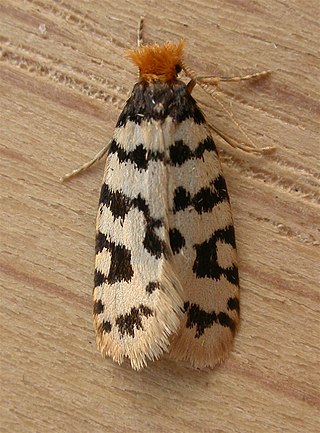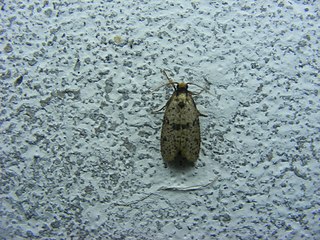
The Psychidae are a family of the Lepidoptera. The bagworm family is fairly small, with about 1,350 species described. Bagworm species are found globally, with some, such as the snailcase bagworm, in modern times settling continents where they are not native.

Friedrich Hermann Loew was a German entomologist who specialised in the study of Diptera, an order of insects including flies, mosquitoes, gnats and midges. He described many world species and was the first specialist to work on the Diptera of the United States.

Eriocottidae or Old World spiny-winged moths is a family of insects in the order Lepidoptera whose position relative to other members of the superfamily Tineoidea is currently unknown. There are two subfamilies, Compsocteninae and Eriocottinae.

Acartophthalmus is a genus of flies, and the only genus with confident placement in the family Acartophthalmidae. They are 1.0–2.5 millimetres (0.04–0.10 in) long, and grey or black in colour, with pubescent arista. Only five species are included.
Halydaia is a genus of flies in the family Tachinidae.

Apterona helicoidella is a moth of the Psychidae family. It is widely distributed in Europe, from Portugal through most of central Europe and the Alps up to the Ural. It is also found in the Balkan and Turkey. It was introduced in the United States by accident during the 1940s. It is now found in many mid-Atlantic states, including Pennsylvania, and has also been reported in the Pacific coastal states, Colorado, Michigan, Nevada, Utah and Idaho. It has also been collected in Ontario.
Leguminivora is a genus of moths belonging to the subfamily Olethreutinae of the family Tortricidae.

The Museum Witt Munich (MWM) is a department of the Bavarian State Collection of Zoology. It is located in Munich, Germany, and has the world's leading collection of moths.
Setolebia is a genus of beetles in the family Carabidae, containing the following species as of 2017:
Amerila phaedra is a moth of the subfamily Arctiinae. It was described by Weymer in 1892. It is found in Kenya, Mozambique, Tanzania and Zimbabwe.
Sapheneutis pulchella is a species of bagworm moth native to eastern Madagascar.
Typhonia bimaculata is a species of bagworm moth native to Madagascar.

Typhonia is a genus of moths of the Psychidae family.
Degia imparata is a moth in the Psychidae family. It is found in China (Yunnan), Vietnam, Thailand, Malaysia, Borneo, the Philippines and Sumatra.

Acanthopsyche is a genus of moths in the Psychidae family. The genus was named by the Dutch entomologist Franciscus J.M. Heylaerts.
Degia deficiens is a species of moth in the Psychidae family. It is found on Sarawak and the Philippines (Palawan).
Westia cyrtozona is a moth in the Psychidae family. It is found in the Philippines.
Westia is a genus of moths in the family Psychidae. It was described by David Stephen Fletcher in 1982.
Compsoctena is a genus of moths in the family Eriocottidae. It was erected by Philipp Christoph Zeller in 1852.
Eumeta variegata, commonly known as the paulownia bagworm or cotton bag worm, is a moth of the family Psychidae. The species was first described by Snellen in 1879. It is found in Japan, Papua New Guinea, India, the Solomon Islands and Sri Lanka.







